healthy
LIFE-CHANGING ORTHOPEDIC CARE FOR KIDS
TRANSPLANTS:
THE GIFT OF LIFE TAME THE PAIN FROM CARPAL TUNNEL SYNDROME


LIFE-CHANGING ORTHOPEDIC CARE FOR KIDS
TRANSPLANTS:
THE GIFT OF LIFE TAME THE PAIN FROM CARPAL TUNNEL SYNDROME


4. AN EASY-TO-SWALLOW SOLUTION. An advanced procedure helps the esophagus function.
5. KEEP CHRONIC DISEASES IN CHECK. Key steps to improve lifelong wellness.
6. TOMORROW’S CANCER TREATMENT TODAY. Specialized therapies are transforming cancer care.
8. IMPROVING HEART HEALTH. Providing advanced services close to home
10. LIFE-CHANGING CARE FOR KIDS. A pediatric orthopedic program brings many services under one roof.
12. UNDERSTANDING ENDOMETRIOSIS. Learn the facts about this oftenmissed gynecologic condition.
14. THE GIFT OF LIFE. A mother’s organ donation gives her son a new chance for a healthier future.
16. ALL IN THE WRIST What you need to know about carpal tunnel syndrome.
www.rwjbh.org
RWJBarnabas Health complies with applicable federal civil rights laws and does not discriminate on the basis of race, color, national origin, age, disability or sex. For more information, see the link on our home page at www.rwjbh.org.
RWJBarnabas Health provides free language services, including qualified interpreters, to people whose primary language is not English. The following Language Assistance Services information is provided in multiple languages.
ESPAÑOL
ATENCIÓN: Si habla español, tiene a su disposición servicios gratuitos de asistencia lingüística.
Llame al 1.844.465.9474
繁體中文
注意:如果您使用繁體中文,您可以免費 獲得語言援助服務。
致电1.844.465.9474
한국어
주의: 한국어를 사용하시는 경우, 언어 지원 서비스를 무료로 이용하실 수 있습니다. 1.844.465.9474 로 전화하십시오.
PORTUGUÊS
ATENÇÃO: Se fala português, encontram-se disponíveis serviços linguísticos, grátis. Ligue para 1.844.465.9474
ગુજરાતી
સુચના: જો
POLSKI
UWAGA: Jeżeli mówisz po polsku, możesz skorzystać z bezpłatnej pomocy językowej. Zadzwoń pod numer 1.844.465.9474
ITALIANO
ATTENZIONE: In caso la lingua parlata sia l’italiano, sono disponibili servizi di assistenza linguistica gratuiti.
Chiamata 1.844.465.9474
@RWJBarnabasHealth
@RWJBarnabas
RWJBarnabas Health
RWJBarnabas_Health
linkedin.com/company/
RWJBarnabasHealth
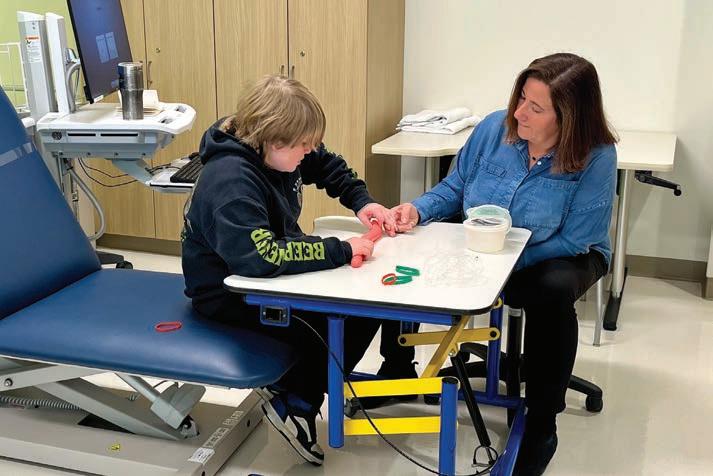
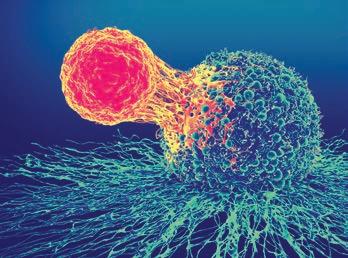

18. PREDICTING FREEDOM FROM SEIZURES. A new way to tell who benefits from epilepsy surgery.
20. BEAT BINGE EATING. Recognizing and treating a common eating disorder.
21. ‘THEIR EFFORTS ARE EXTRAORDINARY.’ DAISY Awards recognize nurses.
22. A VISIONARY SERVICE. The Aira app helps visually impaired patients.
23. HELPING ENSURE FOOD SECURIT Y. SNAP navigators guide residents to nutrition assistance.



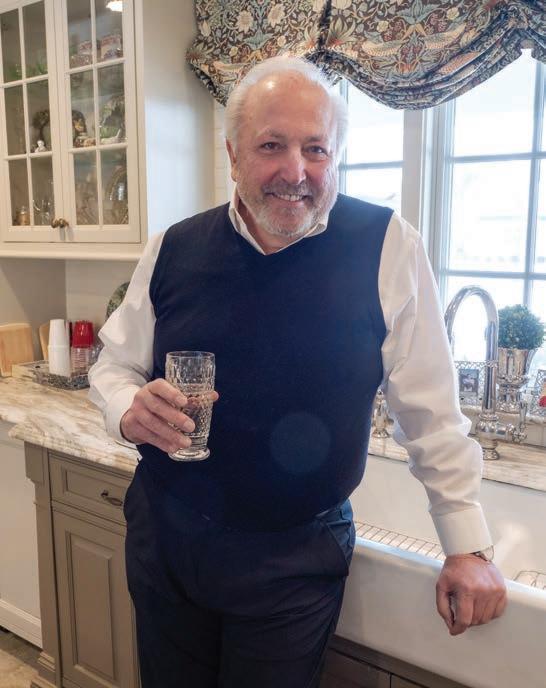
In spring 2020, Gerald (Jerry) Corrado and his wife, Nancy, of Franklin Lakes came down with COVID-19 like many others. While neither needed to be hospitalized, they were sick for six weeks. Both recovered, but during his illness, Jerry developed a cough that wouldn’t quit.
“It would be so bad that I would start vomiting,” says Jerry, who owns specialty grocery stores in Clifton. “I thought it would go away, but four years later, I still had it.” The condition affected eating: During meals he would suddenly need to regurgitate.
Regurgitation also happened at night, and Nancy became worried. With her encouragement, Jerry consulted several specialists before being referred to interventional gastroenterologist Petros Benias, MD. As Co-Chief of Endoscopy, Robert Wood Johnson University Hospital; Vice President, GI Clinical Operations, RWJBarnabas Health; and a member of RWJBarnabas Health Medical Group, Dr. Benias offers advanced gastroenterology care.
A special test called esophageal manometry helped diagnose Jerry’s problem. The test involves inserting a catheter with pressure sensors down the esophagus—the tubelike structure that transports food from the mouth to the stomach—in order to gauge muscle contractions. Results confirmed that Jerry had a rare swallowing disorder called achalasia.
Achalasia consists of two important esophageal dysfunctions: The esophagus does not transport food correctly as a result of poor contractions, and its lower valve fails to relax. In essence, Jerry’s esophagus was in a constant state of spasm that would not allow food to pass. Food and liquid kept coming up, causing his condition to be confused with esophageal reflux.
becomes dilated and enlarged, and the opportunity to treat it with straightforward interventions becomes difficult,” says Dr. Benias.
When caught early, achalasia can be treated by cutting the lower esophageal sphincter, and today this can be done with minimally invasive endoscopic surgery. In end-stage achalasia, sometimes the entire esophagus needs to be removed.
Dr. Benias had the expertise to recommend a procedure called POEM (peroral endoscopic myotomy). Performed on an outpatient basis, POEM involves the use of an endoscope—a flexible tube with a light and camera attached.
“We pass the necessary tools through or along the endoscope and cut the muscle of the lower esophagus,” Dr. Benias explains. Loosening the muscles allows the esophagus to empty its contents.
“The majority of patients do very well,” says Dr. Benias. “Most go home the same day.”
That was true for Jerry. “I went in one morning, they put me out, I woke up and I was fine,” he says. After a day of fasting and a few weeks on a special liquid diet, he felt back to normal.
While POEM is available in most states, not all gastroenterologists are trained to perform it. “It requires tremendous expertise and training,” Dr. Benias says.
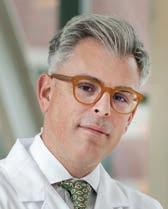
“In severe achalasia, the esophagus
To learn more about digestive health care at RWJBarnabas Health, visit www.rwjbh.org/rwjuhdigestivehealth
Dr. Benias and other specialists are working with national gastroenterology organizations to train more physicians. “We’ve created courses and workshops to help the next generation learn the techniques of POEM,” he says.
What causes achalasia isn’t clear. One theory is that having an inflammatory condition or autoimmune disorder can damage or destroy the small nerves in the esophagus. “COVID-19, like other viruses, may be associated with achalasia, but we don’t have the data on that,” Dr. Benias says. Other treatments for achalasia can include doing surgery, inflating a balloon in the esophagus to enlarge the opening or administering Botox.

Many people think primary care physicians (PCPs) are mainly doctors they should see for acute problems such as injuries that need stitches or illnesses like the flu or pneumonia.
But your PCP is also the first line of defense against chronic conditions— diseases or disorders that tend to persist over time. Examples of chronic diseases include diabetes, arthritis, cancer, cardiovascular conditions such as high blood pressure and breathing-related problems such as asthma or COPD (chronic obstructive pulmonary disease).
With chronic conditions, the emphasis is generally less on finding a cure or resolving disorders and more about managing the disease process. You and your primary doctor work together to maximize your health and achieve goals such as improving wellness, preventing the problem from getting worse or reducing your reliance on medication.

“Many chronic conditions are related to each other,” says Thomas Francis, DO, a primary care physician affiliated with Clara Maass Medical Center and a member of RWJBarnabas Health Medical Group. “Even
some acute diseases, such as COVID-19, are linked to chronic conditions such as cardiovascular disease.”
The interconnected nature of chronic conditions makes a PCP—who takes a broad view of your overall health—an important source of guidance about disease management. Dr. Francis points to these measures as important steps in managing a range of chronic health issues.
Each appointment with your primary care doctor is an opportunity to learn more about your condition and finetune your care. “Education is a big part of what we do,” Dr. Francis says.
“Seeing your doctor regularly promotes understanding of the disease and helps anticipate and prevent future complications—or recognize and respond to any complications that do occur.”
Tests proactively track a chronic condition, helping to guide management of the disease, especially the use of medication. If you seem healthy, screenings can flag potential problems in early stages when they’re easier to control. Your doctor
can keep you up to date if new research prompts changes to guidelines.
Keeping physically active is important in just about any disease management program. Doctors generally recommend 150 minutes of moderate activity such as brisk walking each week—but that’s a minimum. “We often push patients to get more than that to optimize health,” Dr. Francis says.
Consuming a healthy diet is a cornerstone of disease management in part because many types of fruits, vegetables, nuts and healthy oils help fight inflammation, which plays a role in a range of chronic conditions, including diabetes, heart disease, arthritis and COPD.
“Obesity is an inflammatory state that’s linked to many chronic diseases,” Dr. Francis says. In some cases, controlling weight through lifestyle measures can improve health enough for patients to reduce or even quit medications for conditions such as Type 2 diabetes.
To learn more about primary care or to make an appointment, visit www.rwjbh.org/medgroupprimarycare
WHAT TO KNOW ABOUT A HIGHLY SPECIALIZED THERAPY THAT’S TRANSFORMING CANCER CARE
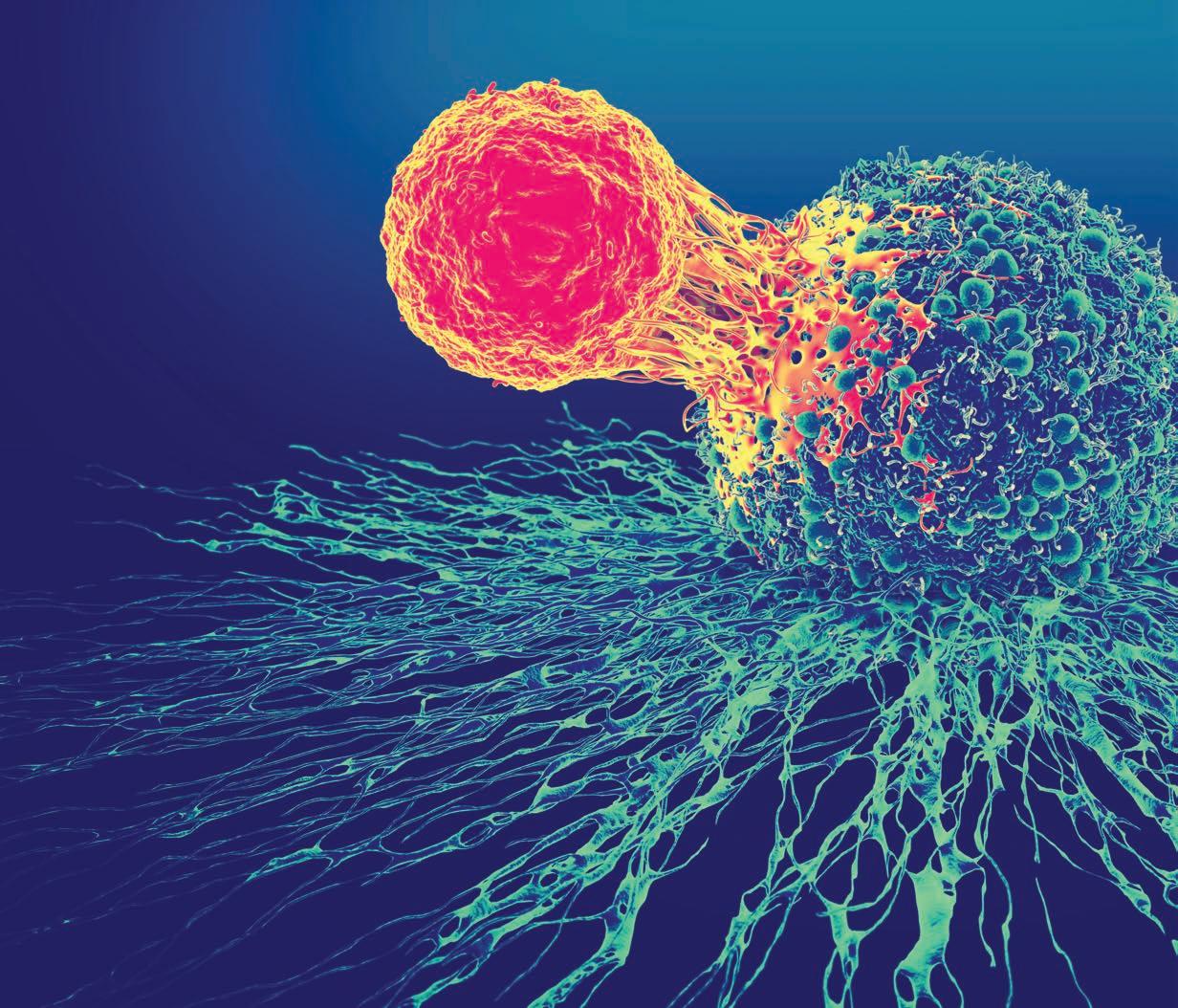
Michael Hreha needed another option. Diagnosed in 2019 with non-Hodgkin’s lymphoma, a type of cancer that affects the body’s lymphatic system, he had already undergone chemotherapy. By summer 2024, the 76-year-old’s cancer had become resistant to the treatment.

Andrew M. Evens, DO, MBA, offered an alternative. As Deputy Director ANDREW M. EVENS, DO, MBA
for Clinical Services and Chief Physician Officer, Rutgers Cancer Institute and Jack & Sheryl Morris Cancer Center, and System Director of Medical Oncology and Oncology Lead, RWJBarnabas Health Medical Group, Dr. Evens knew that Michael could benefit from a groundbreaking type of immunotherapy that uses a patient’s own immune cells to fight cancer.
Called CAR T-cell therapy, the highly specialized treatment is part of a transformative area of research known as cell therapy. Michael is just one of hundreds of patients throughout New Jersey and beyond that RWJBarnabas
Health (RWJBH), together with Rutgers Cancer Institute, the state’s only National Cancer Institute-designated Comprehensive Cancer Center, have treated using CAR T-cell therapy.
“I am incredibly grateful for the opportunity to receive CAR T-cell therapy close to home,” says Michael.
“This treatment has given me a chance to fight back against my cancer and spend more time with my two sons and four grandchildren. I’m looking forward to the future with renewed optimism.”
“Having administered hundreds of CAR T-cell treatments to date is a major milestone,” says Dr. Evens, who
RWJBarnabas Health, in partnership with Rutgers Cancer Institute—the state’s only NCIdesignated Comprehensive Cancer Center—provides close-to-home access to the most advanced treatment options. To schedule an appointment with one of our cancer specialists, call 844.CANCERNJ or visit www.rwjbh.org/beatcancer

To learn more about cancer care at RWJBarnabas Health, visit www.rwjbh.org/beatcancer
is an international leader in lymphoma treatment and research. “It demonstrates our commitment to offering cutting-edge therapies close to home and providing hope to patients like Michael who may have felt their options were exhausted.”
Only a handful of cancer centers across the country provide CAR T-cell therapy, giving New Jersey residents served by the RWJBH system access to a significant oncology advance. Here are key facts you need to know.
Doctors collect T cells (immune system cells that fight illness) from a patient’s blood through an infusionlike process called apheresis. Scientists modify the T cells in a lab, adding a special receptor called a chimeric antigen receptor (CAR) that enables the T cells to seek out and kill cancer cells. When the reengineered CAR T cells are returned to the patient through an infusion, they multiply, seek out cancer cells, attach to them and destroy them.
As the immune system aggressively fights the cancer, most patients experience temporary side effects. Many undergo a phase akin to a severe flu marked by high fever, body aches and fatigue. Medication can help relieve these side effects, and most patients readily recover.
CAR T-cell therapy has shown remarkable success in treating advanced cases of cancers such as blood cancers, lung cancer, melanoma, advanced bladder cancers and more.
Unlike traditional treatments like chemotherapy or radiation, which attack both cancer cells and healthy cells, CAR T-cell therapy precisely targets cancer at the cellular level. By harnessing the patient’s own T cells to recognize and destroy cancer cells, CAR T-cell therapy provides a targeted, personalized approach to cancer treatment.
CAR T-cell therapy operates as a “living drug,” with the potential to provide long-lasting responses, as T cells may continue to fight cancer if there’s a relapse. The therapy may lead to lasting remission and even cure some diseases that have resisted other therapies, giving new hope to patients who even several years ago might otherwise have succumbed to their cancer.
The therapy offers the added advantage of relatively short treatment time and recovery compared with, for example, chemotherapy.
Because it’s a highly personalized treatment, CAR T-cell therapy is available at a limited number of cancer centers around the country with specialized expertise in cellular therapies. For example, centers offering CAR T-cell therapy for blood cancers must also perform stem cell transplants, be certified by the Foundation for the Accreditation of Cellular Therapy and have specially trained clinicians and health care professionals to administer the treatment.
Together, RWJBH and Rutgers Cancer Institute meet these requirements, and their experts are among the nation’s most knowledgeable and experienced in treating blood cancers with immunotherapy. Doctors throughout the RWJBH system collaborate to carefully evaluate all treatment options for a given cancer to decide who is a good candidate for CAR T-cell therapy.
Cancer doesn’t travel well, especially when care is as complex as cellular therapy. CAR T-cell therapy requires multiple stages of care; transitions between providers; coordination and transportation between doctors, labs and manufacturing facilities; and close communication between members of multidisciplinary teams.
Once treatment is completed, the focus shifts to community oncologists for ongoing support and continuity of care. Having all of these resources and capabilities available in a single health system such as RWJBH helps ensure a seamless patient journey.
Researchers are looking for ways to treat more types of cancer using cellular therapy, and to make treatment safer and more effective. Clinical trials to test new innovations in CAR T-cell therapies aim to broaden not only the range of treatable cancers but also the population of people who can receive it. RWJBH and Rutgers Cancer Institute are driving the development of next-generation CAR T-cell therapies through on-site research, which will further propel the future of cancer discovery and care.

Doctors focus on heart health for good reason: Heart disease is the leading cause of death for men and women alike. Significant risk factors for cardiovascular problems are extremely common and include high blood pressure, diabetes, obesity, unhealthy eating, lack of physical activity and elevated levels of certain types of cholesterol.
Improving cardiovascular health throughout New Jersey is a key goal for RWJBarnabas Health. The health system continues to invest in medical expertise, technology, facilities and leadership to meet that goal.
Conor Barrett, MD, MBA, the recently named Chief Clinical Officer and Senior Vice President, Heart and Vascular Services, RWJBarnabas Health, offers his views on the challenges and opportunities of improving heart health in communities statewide.
For decades, RWJBarnabas Health has delivered advanced heart and vascular care while pioneering breakthrough techniques that have revolutionized the field. As an award-winning cardiac care hospital network serving New Jersey, the RWJBarnabas Health Heart and Vascular program is among the top heart programs in the United States. We bring innovation to the changing landscape of heart care with a truly integrated and united network approach to managing care across the system’s 12 hospitals and approximately 100 ambulatory practice locations.
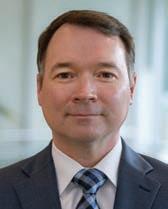
CONOR BARRETT, MD, MBA
RWJBarnabas Health’s extensive
network of cardiac diagnostic, imaging and therapeutic technology—including more than 30 cardiac catheterization labs, ambulatory diagnostic testing, cardiac CT and cardiac PET/CT—is New Jersey’s most comprehensive.
With one of the nation’s largest heart transplant programs (and the only one in New Jersey), RWJBarnabas Health is a leader in advancement of interventions for heart failure patients. More than 1,450 heart transplants have been completed at our two transplant centers: Robert Wood Johnson University Hospital (RWJUH), in New Brunswick, and Newark Beth Israel Medical Center (NBIMC).
Each of the system’s four cardiac surgical centers—Cooperman Barnabas Medical Center, RWJUH, NBIMC and Jersey City Medical Center—is an award-winning cardiac hospital with an integrated and expert team of cardiac specialists.
In addition, as New Jersey’s largest provider of charity care and care to beneficiaries of Medicaid, RWJBarnabas Health is an essential component of New Jersey’s safety net for patients with heart disease.
What are some developments that excite you about the future?
Our heart surgeons continue to enhance outcomes as leaders in minimally invasive valve repair procedures and structural heart abnormalities. As the state’s largest collective structural heart program, we have performed over 5,000 structural heart procedures. We’re also a regional leader in stroke-risk reduction for patients with atrial fibrillation.
In partnership with Rutgers Robert Wood Johnson Medical School and RWJUH, RWJBarnabas Health is also New Jersey’s most comprehensive academic health system. We train tomorrow’s heart specialists through residency and fellowship programs while also advancing breakthroughs in cardiovascular research, conducting more research than any other system in the state. Our broadly integrated fellowship programs include more than 75 fellows in training today. So not only are we providing care to those who need us currently, we are also continuously
investing in educating and mentoring the heart and vascular experts of the future.
How do you see technology making a difference going forward?
RWJBarnabas Health is pioneering advancements in artificial intelligence, imaging and digital health. Through our deep collaboration with Rutgers, as well as SciTech, we continue to innovate and deliver on our mission of advancing cardiac care. As a hub for multidisciplinary collaboration, we bring together cardiovascular scientists, engineers, imagers and trainees to drive innovation from concept to clinical implementation. Our engineering and research efforts are strongly supported by integrated, cross-disciplinary innovation with internationally recognized investigators ranked among the top 1 percent of U.S. physicians.
We’re committed to integrating innovative technologies that directly enhance patient outcomes and the quality of care.
Can you give some examples?
One of our most impactful advancements has been realizing the return on our investment in our Epic electronic medical record system to improve clinical decision-making, patient safety and care coordination.
Since our final site went live in October 2024, we have focused on optimizing Epic to enhance patient scheduling and experience, reduce hospital readmissions and implement critical safety measures. For example, in our critical-care settings, our team designed an initiative that demonstrated how automated alerts to providers’ handheld devices ultimately help prevent complications before they arise.
We continually improve our ability to provide the highest level of care in the most efficient and quality-oriented fashion at a location most convenient to each patient. In essence, we aim to deliver the most advanced care available as close as possible to each patient who needs us. Utilizing our broad cardiac network of providers and our unified, system-wide electronic medical record, we are very well placed to help our patients see the correct heart specialist within the correct timeframe at the most patient-convenient location.
With significant funding from the National Heart, Lung and Blood Institute; the National Science Foundation; and industry partners, we’ve led transformative studies—including the use of wrist-worn sensors for early detection of heart attacks, pocket ultrasound devices to reduce heart failure hospitalizations and AI-driven ECG models (also known as EKG) for diagnosing structural heart diseases. We have also led the way in procedural clinical studies, allowing patients of the RWJBH Heart & Vascular program to access trials not easily available elsewhere.
How does being a comprehensive program benefit patients?
No one plans on heart disease, but everyone should have a plan for it.
Connect with an RWJBarnabas Health heart and vascular specialist at 888.724.7123 or visit www.rwjbh.org/heart.
Factors such as operating New Jersey’s largest advanced heart failure program, having the state’s only heart transplant program, providing 30-plus cardiac catheterization labs with the highest volume in the state, and being equipped with cardiac surgical and hybrid operating rooms have a cumulative impact. They allow innovative technologies to be available not only at our major academic centers but also throughout our heart and vascular network in New Jersey.
Our paradigm of “keeping appropriate care local” is facilitated by both our advanced IT infrastructure and our cardiac network’s broad scale and scope.
By combining advanced technology with a strong focus on patient satisfaction, safety and outcomes, RWJBarnabas Health continues to set new standards in cardiac care, ensuring patients have access to cutting-edge treatments across the state.

A NEW PEDIATRIC ORTHOPEDIC PROGRAM BRINGS MANY SERVICES UNDER ONE ROOF.
Two children with very different challenges show how a newly launched Pediatric Orthopedic Multidisciplinary Program at the Children’s Health network of RWJBarnabas Health (RWJBH) can change kids’ lives—and improve their future outlooks.
John Evans, a then-13-year-old who loves fishing, was helping his dad prepare a moored boat for a storm when he sliced
his index finger while trying to cut a zip tie with a filet knife. Children’s Health pediatric orthopedic surgeon Deidre Bielicka, MD, a member of RWJBarnabas Health Medical Group, recognized how serious the injury was: John had cut both his tendon and nerve in a worrisome location where adhesions could form and limit John’s finger function.
Dr. Bielicka surgically repaired both the tendon and nerve. John then went on
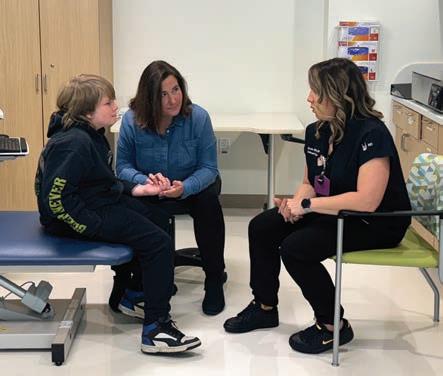
to receive extensive occupational therapy at Children’s Specialized Hospital (CSH) to help his tendons heal, restore motion and regain use of his hand. He’s now back to activities such as fishing and sports.
The other patient, James Martin, uses a wheelchair and has limited muscle function. He came to CSH wanting to improve capability in his right arm to help with everyday tasks such as schoolwork, eating and riding a bike. James first received occupational therapy for about nine months to loosen tightness in his hand and improve motion. Dr. Bielicka then performed surgery that further improved his ability to use his wrist and fingers and allowed him to meet his goals.
“One of the challenges in treating children with complex medical issues is that they often require a lot of different doctors,” Dr. Bielicka says. “Our goal is to put not just the doctors but the therapists and everyone needed for comprehensive care under one roof. That allows us to see those patients together and coordinate their care in a way that hasn’t been possible in New Jersey before.”
The new state-of-the-art Pediatric Orthopedic Multidisciplinary Program is a partnership of CSH and the Pediatric Orthopedics program at The Bristol-Myers Squibb Children’s Hospital at Robert Wood Johnson University Hospital (BMSCH), whose physicians are part of RWJBarnabas Health Medical Group. The groundbreaking initiative provides comprehensive, coordinated

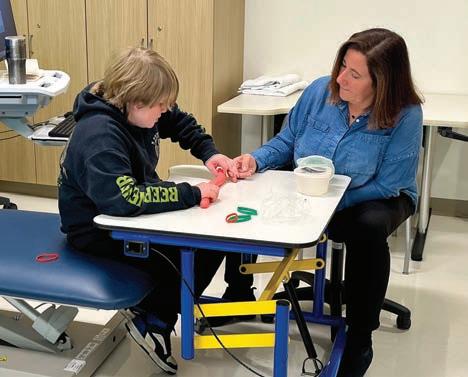
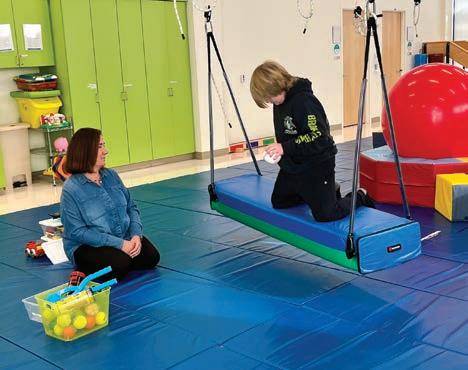
care in one location for children with complex neuromuscular and orthopedic conditions.
Located in East Brunswick, the program offers families the convenience of having multiple specialists working together to ensure the best outcomes for children. RWJBH’s Children’s Health network hospitals are recognized among the nation’s best children’s hospitals by U.S. News & World Report.
The Pediatric Orthopedic Multidisciplinary Program is designed to treat conditions such as cerebral palsy, spina bifida, muscular dystrophy, improper hip development, scoliosis and fractures, along with other orthopedic and neuromuscular disorders, including, for example, joint disorders, upper limb congenital differences and tendon repairs.
“We are thrilled to offer families this unique and comprehensive approach to pediatric orthopedic care,” says pediatric orthopedic surgeon Thomas McPartland, MD. “By bringing together specialists from across disciplines, we are able to provide the highest level of care in a convenient and supportive environment.”
The multidisciplinary pediatric
variety of exercises help John Evans restore
orthopedic team includes experts from various specialties such as orthopedic surgery, physiatry, physical therapy and occupational therapy. Specialists together develop individualized care plans using the latest evidence-based techniques and cutting-edge technologies such as EOS imaging and gait analysis.
“This new partnership brings together nationally recognized experts in surgical and nonsurgical treatments,” says Colin O’Reilly, DO, Vice President and Chief Medical Officer, CSH. “Families can expect expert guidance on everything from mobility equipment and medical tone management to spinal deformity correction and limb reconstruction.”
“We’re really excited about having a multidisciplinary program for kids who have multiple different problems,” Dr. Bielicka says. “With all services in one location, this partnership makes care easier not only for parents and kids
but also for clinicians, who are able to communicate better with each other and with families to make sure we’re taking care of the whole kid and not just individual aspects of a child.”
For example, CSH therapists with advanced training work closely with RWJBH pediatric orthopedic surgeons to complete custom splinting, orthosis fabrication and casting as needed for infants through young adults as part of their treatment or postsurgical needs.
“The multidisciplinary nature of this program allows us to deliver more family-centric, holistic and personalized care,” says Ferd Ferrer, MD, Chief Pediatric Officer at RWJBH. “By collaborating closely across specialties, we can tailor treatments to each child’s unique needs and maximize their functional outcomes.”
Children receiving care through the program have access to a full spectrum of services, including inpatient and outpatient rehabilitation, surgery at BMSCH and ongoing physical and occupational therapy from CSH. Orthotists will also be on-site to address patients’ bracing needs.
James, reflecting on how the Pediatric Orthopedic Multidisciplinary Program’s coordinated services helped him meet his goals and function better in daily activities, sums it up this way: “In this kid’s heart, for me and my mom, [the program] has been a lifesaver.”
To learn more about the Children’s Health network at RWJBarnabas Health, visit www.rwjbh.org/childrenshealth
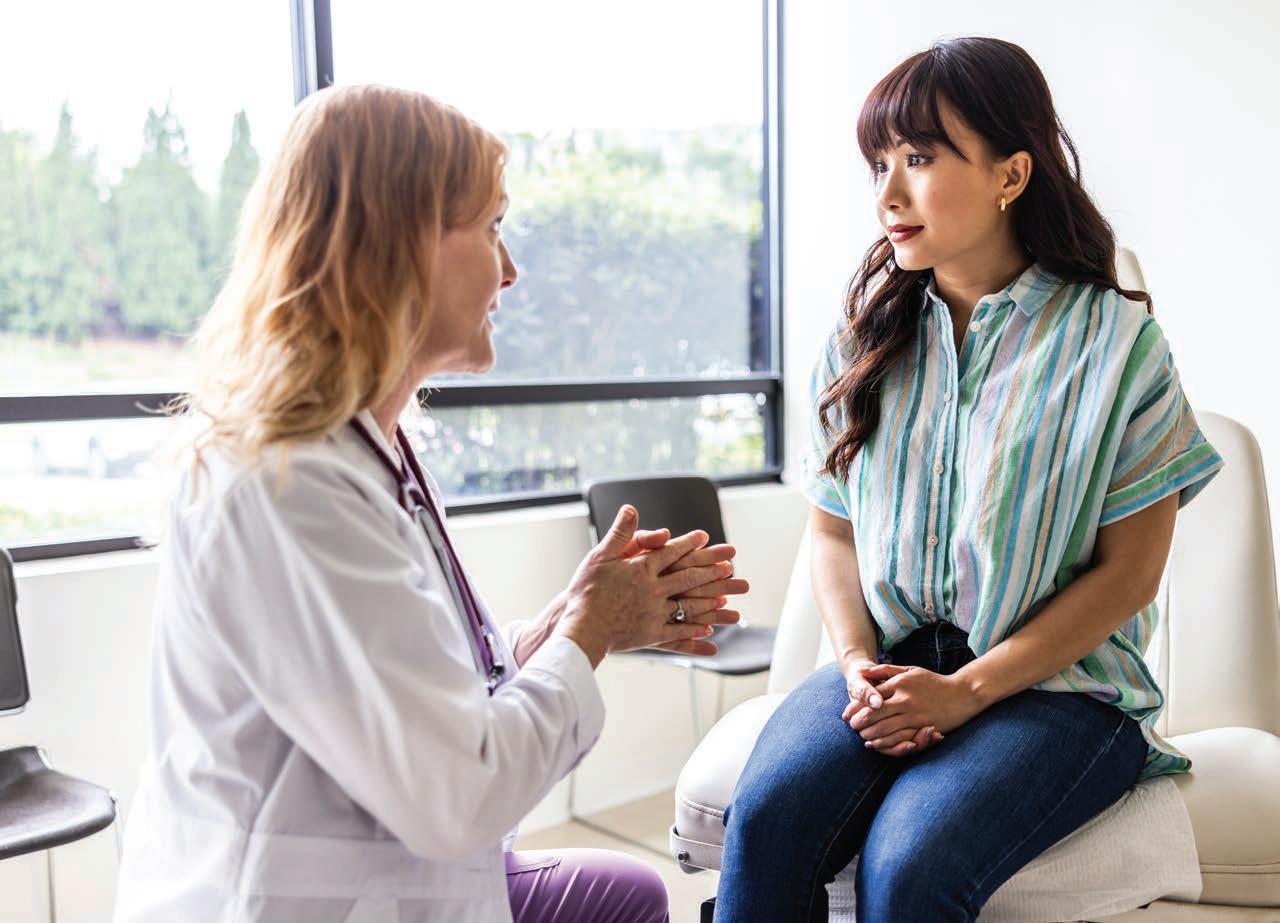
LEARN THE FACTS ABOUT THIS SERIOUS AND OFTEN-MISSED GYNECOLOGIC CONDITION.
Painful periods and intense pelvic pain might be enough to make many women seek medical attention, for good reason: These are symptoms of endometriosis, a common, chronic gynecologic condition. But more subtle signs of endometriosis such as gastrointestinal issues, fatigue and frequent urination often get overlooked. Endometriosis affects about 10 percent of women and girls worldwide but is often undiagnosed, leaving many others to endure the condition in silence. You
can better gauge your risks—and get relief if you’re affected—by understanding answers to questions like these:

What is endometriosis?
Endometriosis is a long-term hormonal and immune disease that can affect women from puberty to menopause. It occurs
when tissue similar to the inner lining of the uterus grows outside the womb, generally on organs in the pelvic cavity such as the ovaries, fallopian tubes and bowel. Cysts, scar tissue and adhesions may form. The condition can be painful and may have a devastating effect on quality of life.
How does lack of awareness boost risks?
Studies show that about 54 percent of people don’t know what endometriosis is. Of those who realize endometriosis is a gynecologic condition, 35 percent can’t name any symptoms.
“Lack of knowledge of the disease combined with stigma causes an average delay of 10 years from onset of symptoms to diagnosis,” says Jessica Opoku-Anane, MD, an obstetrician/gynecologist (OB-GYN) at Robert Wood Johnson University Hospital; a minimally invasive gynecologic surgeon and associate professor and section chief of benign gynecological surgery at Rutgers Health/ Robert Wood Johnson Medical School; and a member of RWJBarnabas Health Medical Group. “At the same time, girls with endometriosis have been shown to be at greater risk for 12 cancers, seven autoimmune diseases, allergic diseases and heart disease. Receiving an early diagnosis and treatment for this condition can have a major impact for patients.”
What causes the condition?
The cause isn’t clear, but possible contributing factors include retrograde menstruation, in which menstrual blood flows back into the pelvic cavity instead of leaving the body; movement of endometrial cells to other parts of the body; the transformation of cells due to hormones or other factors; surgical scar complications; and abnormal immune responses.
What are warning signs to watch for?
Symptoms of endometriosis include periods with pelvic, lower back and stomach pain; heavy periods and/or bleeding between periods; painful bowel movements and/ or urination; pelvic
Surgeons throughout RWJBarnabas Health offer minimally invasive laparoscopic and robotic surgery using the da Vinci Xi Surgical System to treat numerous gynecologic conditions, including endometriosis. The computer-assisted system integrates advanced imaging and sophisticated instruments that allow surgeons to access the body without large incisions. Robotic-assisted procedures are less invasive than traditional surgeries, and using the da Vinci system typically results in comparatively less post-op pain; lower risk of infection and scarring; and faster recovery.
During a procedure, the surgeon sits at a console with tools that virtually extend human eyes and hands. A high-definition camera provides a magnified, 3D view of the entire surgical area. Robotic arms give the surgeon a 360-degree range of motion not possible with a human wrist, allowing precise, real-time movements in delicate and hard-to-reach areas. Such advanced control allows doctors to remove endometriosis tissue more effectively while preserving healthy tissue.
pain outside of periods; and painful intercourse. In addition to frequent urination and fatigue, women also may experience diarrhea, constipation, bloating, nausea and nerve problems. Up to 50 percent of women with endometriosis have difficulty conceiving. Endometriosis can be mistaken for conditions with similar symptoms and is often misdiagnosed as, for example, pelvic inflammatory disease, ovarian cysts, irritable bowel syndrome, appendicitis, ovarian or colon cancer, fibroids, polycystic ovary syndrome or sexually transmitted diseases. Regular pelvic exams and discussions with an OB-GYN and/or endometriosis expert can help identify and correctly diagnose endometriosis.
Women with a low body mass index, those who have never given birth and those with increased estrogen levels carry a greater risk of developing endometriosis. So do those who experience early-onset menstruation or late-onset menopause, short menstrual cycles (less than 27 days) and heavy menstrual flow for longer than seven days. Women who have one or more
close relatives with endometriosis are three to seven times more likely to have the condition.
While no known cure exists for endometriosis, hormone medicines and surgical treatments can help. Lesions tend to extend deep into tissue, and many doctors recommend fully removing the growths through various types of surgery. Hospitals throughout the RWJBarnabas Health system offer minimally invasive laparoscopic and robotic surgery using the da Vinci Xi Surgical System (see sidebar). In some cases, hysterectomy may be suggested. Timely treatment may help halt progression of the disease and reduce associated infertility and pain. “It’s really important to get the diagnosis as early as possible to treat either with hormonal medications or surgery to try and prevent that progression,” says Dr. Opoku-Anane. “Women who have bad periods that truly affect their lives should not wait to see a physician. If your menses are preventing you from doing your normal activities, that’s not normal. You should see your OB-GYN.”
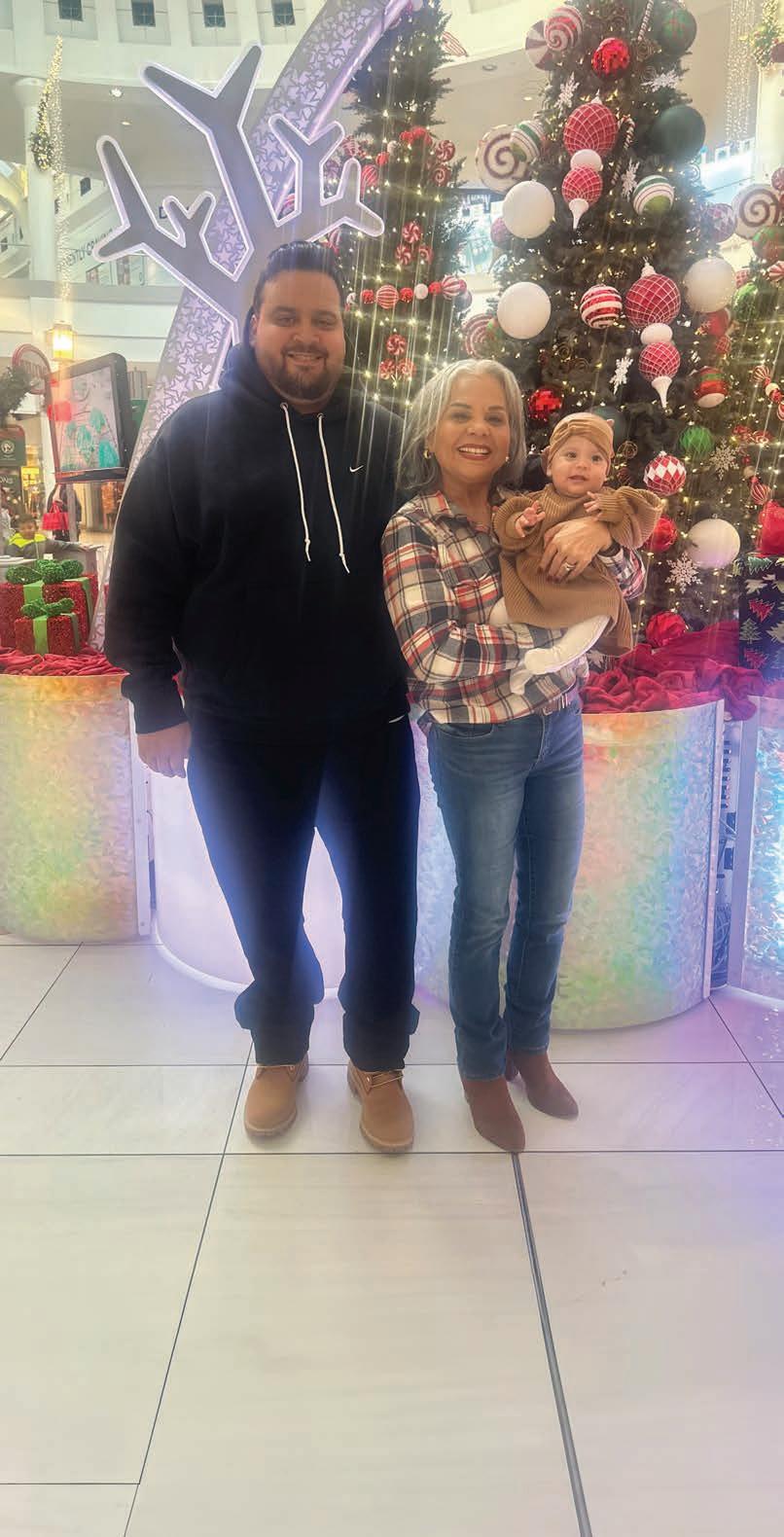
Daisy Vasquez was concerned when she learned that her adult son, Carlos, had been diagnosed with kidney disease. In 2017, Carlos spent a month in the hospital undergoing dialysis followed by another month of dialysis at home before doctors were able to discontinue treatment. “We thought that was the end of the ordeal,” Daisy says.
Unfortunately, five years later, Carlos’ kidney function began to decline again. He had entered end-stage kidney disease, and a kidney transplant would be his best hope of returning to a normal life.
Almost immediately upon hearing the news, Daisy made the selfless choice to become a living kidney donor. “Seeing Carlos live his life fully today is all the thanks I need,” she says. “Now Carlos is in a great place—healthy and thriving. I’ve also recovered wonderfully, and I don’t regret a single moment of my decision.”
Stories like that of Carlos and Daisy are more common than many might think. About 100,000 people in the U.S. are awaiting a lifesaving organ, eye or tissue transplant, including about 4,000 who live in New Jersey, according to NJ Sharing Network.
Sadly, about 5,600 Americans die each year while waiting for a viable
organ, according to Donate Life America. Living donors bridge the gap between eligible patients and available organs, allowing more people to receive the transplant surgeries they desperately need.
“Living donors are the kindest, most selfless people anyone can meet,” says Francis Weng, MD, a medical nephrologist at Cooperman Barnabas Medical Center (CBMC) and a member of RWJBarnabas Health Medical Group. “They are often family members, friends or acquaintances of the recipient. When they learn their loved one needs an organ, they volunteer without hesitation.”
Over the past two years, living donors accounted for about 6,000 of the nearly 28,000 kidney transplant surgeries performed nationally, Dr. Weng says. Kidneys from living donors tend to last longer on average than those from deceased donors. “Ninety-three percent of kidneys from living donors are still working after three years,” Dr. Weng says.
Underlying conditions such as diabetes, obesity or high blood pressure often trigger end-stage kidney disease. In Carlos’ case, the cause was vasculitis, an autoimmune condition that attacked his kidneys.
“I was with him when we heard the news that Carlos needed a kidney transplant, and as a mother, I wanted to help,” Daisy says. “If I could’ve given Carlos my heart, I would have.”
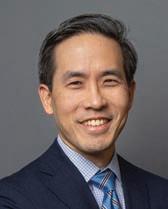
Shortly thereafter, Daisy contacted the Living Donor Institute at Cooperman Barnabas Medical
Center and started the donation process, which included education from a transplant physician, a social worker, a registered nurse and an independent living donor advocate.
“We evaluate donors like Daisy to make sure they’re ready for both the medical and psychological impact of donating,” Dr. Weng says. “Donors also have bloodwork sent to NJ Sharing Network, whose labs do tests to see if the donors are a match for their recipients.”
In March 2023, Carlos underwent a successful living donor kidney transplant with an organ from his mother. “The entire transplant team at CBMC was incredible,” Daisy says. “From start to finish, the care Carlos and I received from the staff was exceptional.”
A team approach is a defining quality of CBMC’s kidney transplant program. “It takes a village to perform a successful transplant,” Dr. Weng says. “We’re fortunate to have a team that collaborates collegially. All of us feel a strong obligation to do what’s best for our patients and to honor the gift of life, whether from a living or deceased donor.” In 2024, the CBMC team performed 383 kidney transplants.
Daisy, who recently became a grandmother, is now a staunch advocate for kidney donation. She shares her story with others and volunteers with NJ Sharing Network.
“So many people are waiting for organs, and becoming a donor has only made my life better,” she says. “Being able to give Carlos the gift of life is a blessing, and I hope our story inspires others to do the same.”

RWJBarnabas Health (RWJBH) is home to the largest transplant program in New Jersey, restoring lives through kidney, heart, pancreas and lung transplants. Since its establishment in 1988, the program has performed more than 12,500 organ transplants for adults and children, including 525 in 2024 alone.
RWJBH doctors and medical teams provide care for thousands of transplant patients annually. Through their participation in research and clinical trials, the program’s doctors bring the latest advances in transplants to patients. The unique, multidisciplinary program:
• Has the sixth-largest kidney transplant program in the U.S. • Is among the nation’s top 10 for heart transplants
• Offers New Jersey’s only lung transplant program
“Our transplant physicians use advanced techniques offered at only a few of the world’s leading medical centers,” says Francis Weng, MD, of Cooperman Barnabas Medical Center. “With the help of our experienced transplant coordinators, social workers and support staff, they deliver top-quality, compassionate care.”

CARPAL TUNNEL SYNDROME IS OFTEN MISUNDERSTOOD. HERE’S WHAT YOU NEED TO KNOW.
Do you feel a pins-and-needles sensation in your thumb, index, middle or ring finger? It could be carpal tunnel syndrome (CTS). You’ve probably heard of it: Popularly linked to keyboard work, CTS affects up to 10 million Americans. Yet plenty of misconceptions exist.
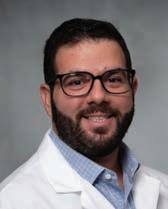
“Many people believe that carpal tunnel surgery creates permanent numbness or that typical recovery
takes an extremely long time, but neither is true,” says Bishoy Saad, DO, a hand, wrist and upper extremity surgeon at Jersey City Medical Center (JCMC) and Cooperman Barnabas Medical Center (CBMC), and a member of RWJBarnabas Health Medical Group.
To promote better understanding of CTS, Dr. Saad shares answers to some of his patients’ most frequently asked questions.
What is CTS?
While CTS affects hands and fingers, it’s actually a condition of the wrist. It occurs when the median nerve—which
runs through a wrist structure called the carpal tunnel—becomes compressed, putting pressure on the nerve.
What are key symptoms?
In addition to numbness and tingling, symptoms may include pain or a burning sensation in the wrist, hand or forearm. Discomfort often gets worse at night, making sleep challenging. People with CTS may also have trouble gripping a coffee mug or buttoning clothes.
Are keyboard users most at risk?
Excessive keyboard or computer use can cause CTS, but so can any other type of
• Take frequent short breaks to rest your hands and stretch your wrists.
• Maintain good posture and avoid slouching. If you work at a desk, position your keyboard and mouse to keep your wrists straight, and adjust your chair so your feet are flat on the floor and your forearms are level with the keyboard.
• Avoid repetitive gripping.
• Tr y wrist exercises. For wrist flexor stretches, extend your arm with palm up while gently bending your wrist back with your other hand. For wrist extensor stretches, extend your arm with palm down while gently bending your wrist down. Exercises from a hand therapist can help improve tendon movement.
• Maintain a healthy weight, and control conditions such as diabetes and arthritis.
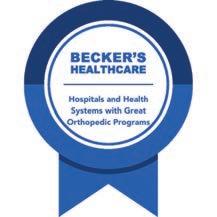
repetitive hand motion, such as playing guitar or cutting hair. CTS is often seen in people who use their hands in work or hobbies, including assembly-line and construction workers, cashiers, gardeners and knitters. Pregnancy and chronic conditions such as diabetes, rheumatoid arthritis, thyroid disorders and obesity can contribute to CTS, too.
Is CTS genetic?
It can run in families. One cause is anatomical; it occurs more often in people with a smaller carpal tunnel. CTS is three times more likely to occur in women than men, especially women over 45, likely due in part to hormonal changes.
Is surgery the only treatment?
No. Many mild-to-moderate CTS cases can be treated nonsurgically. Options include over-the-counter pain medications and wearing a splint to keep a hand in a neutral position, especially at night.
Avoiding repetitive motions or improving the setup of your workspace can help. Hand therapy can improve the movement of the median nerve. Corticosteroid injections can reduce inflammation for temporary relief.
When should surgery be considered?
We recommend surgery when symptoms are severe and you fail to find significant relief with more conservative treatments.
What does surgery do?
Two types of surgery—open and endoscopic—reduce pressure on the
median nerve by cutting a ligament atop the carpal tunnel.
An open approach involves a larger incision—about two inches— in the palm. An endoscopic approach involves a smaller incision of about half an inch. It’s performed using an instrument with a camera that allows doctors to visualize and cut the ligament.
The endoscopic procedure generally entails smaller scars, faster healing and less blood loss. Our team performs endoscopic CTS surgeries at RWJBarnabas Health outpatient surgery centers in Livingston and Jersey City.
How long does recovery take?
Most patients improve significantly and can return to light activities within just a few weeks, gradually resuming more strenuous activities over the following one to three months as grip strength improves. Full recovery might take several months to a year.
When should I see a doctor for CTS?
Seek care if you feel persistent or worsening numbness in your hand that’s interfering with daily activities or if hand and wrist pain is keeping you up at night. Early diagnosis and treatment can prevent nerve damage and ease discomfort.
For the second consecutive year, RWJBarnabas Health (RWJBH) has been named among the 100 Hospitals and Health Systems with Great Orthopedic Programs by Becker’s Hospital Review. The recognition honors orthopedic programs that:
• Deliver comprehensive, compassionate care for patients with musculoskeletal conditions and injuries
• Offer minimally invasive treatments
• Conduct forward-thinking research
• Perform breakthrough clinical trials that drastically improve patient outcomes
Programs on Becker’s list also have earned recognition from organizations such as U.S. News & World Report, Newsweek and Healthgrades; receive funding from organizations such as the National Institutes of Health; serve as official providers for elite sports teams; and hold the Gold Seal of Approval from The Joint Commission.
RWJBH offers comprehensive orthopedic services for adults and children to help manage conditions caused by arthritis, degenerative joint disease, injuries, congenital issues and general wear and tear. Orthopedic services offered at RWJBH acute care, ambulatory care and rehabilitation facilities throughout New Jersey include emergency and trauma care, diagnostic testing, minimally invasive and robotic surgery, sports medicine and rehabilitation services.
To learn more about orthopedic care at RWJBarnabas Health, visit www.rwjbh.org/ortho

RESEARCHERS FIND A NEW WAY TO TELL WHO COULD BENEFIT MOST FROM EPILEPSY SURGERY.
Epilepsy can be difficult on many levels. Various types of seizures that are part of this neurological disorder can disrupt normal life. And outcomes from treatments such as medications and surgery can be challenging to predict.
Now an advance from researchers at RWJBarnabas Health (RWJBH) and Rutgers Health is helping to clarify some of the uncertainties about surgical treatment. The researchers’ new findings may encourage patients to seek effective care that they otherwise might have avoided.
Seizures from epilepsy arise when nerve cells don’t signal properly, causing surges of electrical activity that can affect brain and muscle function.
Medications can help people with epilepsy experience fewer or lessintense seizures. But finding the right medications in the right combinations at the right doses can be difficult. About a third of the nearly 3 million Americans who have epilepsy don’t respond adequately to medications.
For these patients, surgery to remove or disable the part of the brain causing seizures can be an effective treatment. Surgical options include traditional open surgery along with minimally invasive approaches that use laser technology. But which patients will emerge seizure-free after surgery often isn’t clear ahead of time.
To help address the challenge of predicting outcomes, RWJBH and Rutgers researchers, along with colleagues at Emory University, honed complex methods to create a simple scoring system. The scoring can give doctors a more precise idea of when patients will likely become seizure-free after minimally invasive epilepsy surgery.
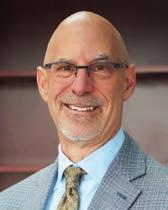
The researchers’ study, published in the Annals of Clinical and Translational Neurology, introduces a predictive model—a statistical tool that uses past
data to identify patterns and create forecasts—that could expand access to surgical treatment. Experts say surgery for epilepsy is underused, so a tool that better identifies good candidates for procedures could potentially result in life-changing improvements for more patients.
Many patients hesitate to undergo traditional open, invasive brain surgery out of concern about the pain and recovery associated with it as well as the possibility of cognitive side effects. Minimally invasive laser procedures may be more appealing, especially if patients can get a clearer picture of their chances for success.
“We’ve pried open the therapeutic window with this minimally invasive approach,” says Robert Gross, MD, senior author of the study, who is Senior Vice President of Neurosurgical Services and co-lead of Neuroscience at RWJBH and chair of the Department of Neurosurgery at Rutgers Robert Wood Johnson Medical School and Rutgers New Jersey Medical School. “Now the question is, how well do we think the patients are going to do [based on] the information we have before doing the procedure?”
The predictive model that researchers developed draws on data from 101 patients who underwent a minimally invasive treatment called SLAH (stereotactic laser amygdalohippocampotomy). This procedure uses a type of laser therapy called LITT (laser interstitial thermal therapy) to target and disable a small area of the brain that causes seizures in many patients.
Using an innovative approach, researchers identified eight clinical factors associated with a higher likelihood of becoming seizure-free after the SLAH procedure. The factors include the patient’s history, certain abnormalities in results of their MRI scans, brain lesions and the presence or absence of certain signs and symptoms.
In their approach, the researchers chose not to rely on complex statistical models.
Instead, the team created a simple 8-point score, assigning a point for each factor present.
This approach outperformed other predictive models. For example, it did better than models based on more complex multivariate analyses (which simultaneously consider numerous variables) or those based solely on results from MRI scans (a common way to predict surgery outcomes).
Patients scoring 6 or higher on the 8-point scale had a 70 to 80 percent chance of becoming seizurefree after SLAH—a success rate comparable to that of conventional open surgery. Those with lower scores had progressively lower chances of a positive outcome.
Dr. Gross has already seen how the new scoring system could help patients gauge their options. With one recent patient, “I was able to go to this young woman and her mother and say, ‘OK, let’s look at this: You’ve got a 71 percent chance of being seizurefree,’” he says.
While such uses are now possible, researchers say the model still needs further validation using larger amounts of data on patient outcomes. They also note that the scoring system doesn’t account for all factors that might affect surgical outcomes, such as the exact ratio of abnormal brain activity between hemispheres of the brain or specific seizure traits.
Despite these limitations, the study authors say their work represents a significant step in personalizing epilepsy treatment. Providing a more nuanced and accurate prediction of surgical outcomes with this new tool could help more patients with drugresistant epilepsy find effective relief through minimally invasive surgery.
As research continues, further refinements to the model are in store. With more data and more study, researchers look toward developing even more precise predictions—and better patient outcomes.

Binge eating disorder is the most common eating disorder in the U.S.
But it’s not always recognized as a serious medical problem because patients don’t necessarily face immediate health risks from their disordered behavior. Yet binge eating can have serious long-term consequences if not addressed.
Matthew Johnson, DO, Medical Director of the Eating Disorders Program at Robert Wood Johnson University Hospital (RWJUH) Somerset and Clinical Assistant Professor at Rutgers Medical School, explores the condition and how treatment can help.
What is binge eating disorder?
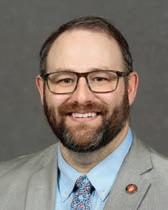
Binge eating disorder occurs when people consume food in larger amounts than would normally be expected—even if they’re already full or not hungry. Often, they experience significant weight gain or already had elevated weight.
How is it different from eating disorders like bulimia and anorexia?
With binge eating disorder, there’s no compensatory behavior such as purging. And with bulimia and anorexia, there’s usually no weight gain.
How do you know if binge eating is a problem for you?
One sign is if you’re consistently eating more and faster than usual, even when you have no appetite or you’re no longer hungry. People with binge eating disorder often feel a loss of control over food intake. They sometimes eat alone and isolate themselves because of that, and they may feel embarrassed, disgusted, depressed or guilty after eating.
Why is binge eating dangerous?
Unlike bulimia and anorexia, which carry a more imminent risk and danger, the risks of binge eating are more long-term. Over time, people with binge eating disorder are at risk of serious health issues such as obesity, Type 2 diabetes, high blood pressure and various types of heart disease, each of which can lead to other problems.
For more information about the Eating Disorders Program at Robert Wood Johnson University Hospital Somerset, visit www.rwjbh.org/eatingdisorders
The Eating Disorders Program at Robert Wood Johnson University Hospital Somerset opens doors to recovery from binge eating disorder and other disordered eating behaviors.
How is binge eating disorder treated?
In general for eating disorders, the primary treatment is therapy that helps get to the root cause or causes, which may include trauma or difficulty with mood regulation, for example. We often take a health-at-every-size perspective while targeting underlying cause(s) and work toward changing behaviors and thought patterns that surround eating. With that said, it’s not uncommon for patients to see their weight decline naturally as the underlying issues are addressed and food intake patterns change. However, weight loss in particular isn’t the goal with treatment of the eating disorder itself. Concerns or risks that may otherwise surround an individual pertaining to their weight may be better addressed once the eating disorder is in remission.
How successful is treatment?
It can be very successful—but only as successful as the effort an individual puts into it. It’s possible to experience complete remission. And the prognosis is very good.
What’s special about the RWJUH Somerset program?
The Eating Disorders Program is part of RWJBarnabas Health’s Behavioral Health Services together with Rutgers Health University Behavioral Health Care. We are one of only two inpatient hospitals for eating disorders in the state, and one of very few partial hospitalization and intensive outpatient programs to treat binge eating and other eating disorders. We treat both adolescents and adults, and our dietitians, therapists, doctors and nurses are focused on treating eating disorders and restoring healthy eating behaviors. This may include helping patients in other ways such as addressing, for instance, mood dysregulation; medication regimens requiring a change or titration; overlapping addictions; and various other comorbid or exacerbated medical conditions.
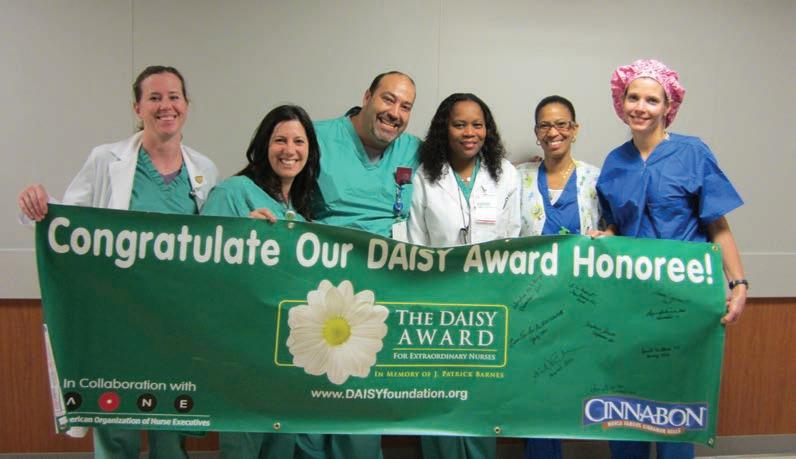
Below are comments describing just a few of the many RWJBarnabas Health nurses nominated for DAISY Awards.
Maryse Annulysse, MSN, RN, CCRN
RWJBarnabas Health School of Nursing
“Her compassion and caring are genuine. This is the way we want to see our students practicing as nurses.”
Zakiyah Rawlins, RN
Jersey City Medical Center
“From the moment we arrived on the unit, we felt at ease because of the excellent care that Zakiyah had given to us.”
Dustin Bullock, RN
Robert Wood Johnson University Hospital Hamilton “Dustin respected me and put me at ease.”
Lori Prussack, RN
‘THEIR
THE DAISY AWARD FOR NURSES LETS PATIENTS, FAMILIES AND COLLEAGUES OFFER PRAISE AND THANKS.
For a sense of how important nurses are to health care, just listen to what patients and families say.
“She has made me feel so comfortable while I have been here,” says a patient. “She provided not only my father with the best care but me as well,” says a family member. “[She] deserves this honor because of the impact she has had in helping the underserved population of the area identify cancer,” says another care receiver.
These are just a few examples of praise for RWJBarnabas Health (RWJBH) nurses who are among the most recent recipients of The DAISY Award, bestowed by The DAISY Foundation based on nominations from patients, families and colleagues.
Each year, nurses in all types of health care settings across the country, around the world and throughout the RWJBH system are honored with DAISY Awards to recognize their care, compassion, skill and contributions that made a difference to a patient, their family or a coworker.
“Nurses often take for granted the work they do, but their efforts are extraordinary,
and that’s what DAISY represents,” says Kathy Easter, MSN, RN, CCRN-K, Assistant Vice President, Nursing Excellence, RWJBH. “The award represents caring and placing patients and families at the center of what we do.”
The DAISY Award was started by the family of a Seattle man named Patrick Barnes who died of an autoimmune disease in 1999. During his illness, the family experienced the best of nursing.
Out of appreciation for nurses’ kindness, compassion and sensitivity, the family founded the nonprofit DAISY Foundation (the acronym stands for Diseases Attacking the Immune System) to honor Patrick and thank nurses. The DAISY Award has since been adopted by
Robert Wood Johnson University Hospital
“When they say, ‘Treat the patients as if they were your own family members,’ she truly embodies that.”
thousands of health care organizations and nursing schools.
Award presentations are held at different times of the year across the health system at every hospital, and often gather hospital colleagues, along with hospital and executive leadership, for a recognition ceremony that in many cases surprises the recipient.
“The award recognizes that we not only care for patients and families but for each other,” says Nancy Holocek, MAS, MHA, BSN, RN, FNAP, Executive Vice President and Chief Nursing Officer, RWJBH. “It’s about kindness, which reflects the culture and values of our health system, and inspires our nurses.”
Nurses who receive the award feel honored—and often moved. “It is personal for that nurse, and pretty emotional,” Easter says. “It’s very celebratory and special because it is a personal recognition about the nurse and nursing practice that comes from the heart.”
To learn more about The DAISY Award or to nominate a nurse at RWJBarnabas Health, visit www.rwjbh.org/daisyaward by scanning this code.
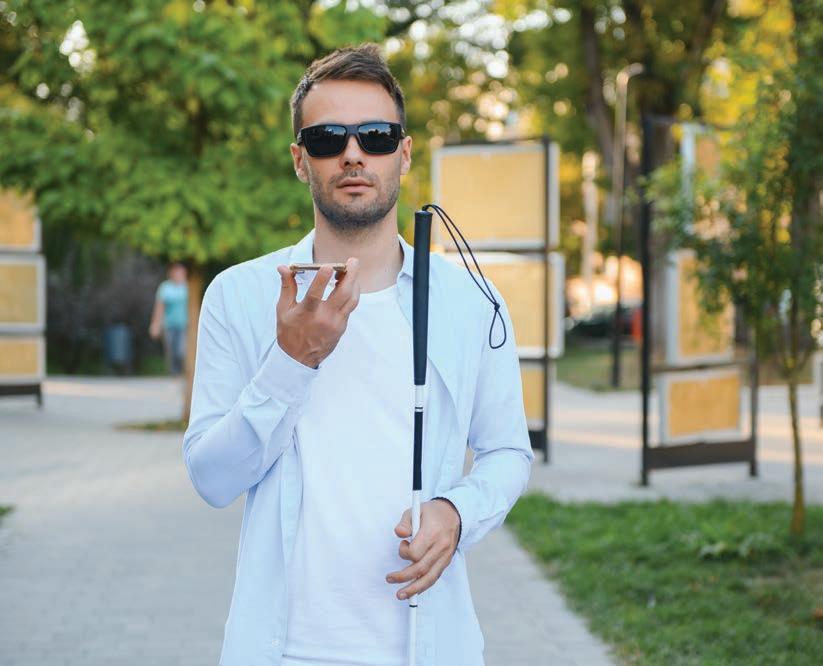
A FREE APP HELPS VISUALLY IMPAIRED PATIENTS NAVIGATE AND MEET THEIR HEALTH CARE NEEDS.
Navigating health care can be taxing for many people, but it can be especially challenging for those who are blind or visually impaired.
That’s why RWJBarnabas Health (RWJBH) offers Aira, an innovative mobile app that provides on-demand remote visual interpretation services for people who have lost their sight or experience low vision. The health system expanded the service in 2024, after piloting it years before at Robert Wood Johnson University Hospital Somerset as part of an ongoing commitment to accessibility, inclusion and equitable care.
“Aira connects users to trained visual interpreters, or agents, who provide real-time guidance to help them navigate various tasks,” says Suzette Robinson, Senior Vice President and Chief Diversity, Equity and Inclusion Officer at RWJBH. “The service is available free to all patients, visitors, employees,
volunteers, providers and vendors within our acute-care facilities and medical group offices.”
Accessibility challenges too often keep people from seeking health care. Aira eliminates barriers and increases accessibility by helping blind and low-vision people seamlessly complete a variety of necessary tasks. “It empowers users to navigate health care spaces with independence and dignity,” says Robinson.
Anthony Rodriguez, a 33-year-old New Brunswick resident, knows this firsthand. Blind since age 17, Anthony uses Aira regularly and finds it indispensable.
“It has been completely lifechanging,” he says. “It does everything my eyes are supposed to do but can’t. The agents are real people, not bots, so I can interact better with them.”
With the Aira app, trained visual interpreters help people who have lost their sight or are visually impaired navigate health care settings.
He especially appreciates that agents don’t just give generic instructions but are able to answer questions and offer explanations. “If I have a doctor’s appointment, the agent will not only tell me how to get there, but will guide me to be sure I’m walking in the right direction and taking the safest, fastest route through the facility,” he says.
Aira is available 24 hours a day, seven days a week at RWJBH hospitals and medical group offices, and provides immediate access to an agent.
“Users simply download the app from the iOS App Store or Google Play, launch it on their smartphone and connect with an Aira agent for immediate assistance,” says Robinson.
“It’s like picking up the phone and calling a friend who is always there to help you,” says Anthony. He even uses Aira to help him access his MyChart patient portal. “I can share my computer screen with the agent and they help click on the information I need, read test results or messages, or help me fill out forms and submit them,” he says.
Anthony affirms that Aira helps him feel independent. “When you use the app, you don’t feel like you’re being a burden to anyone,” he says. “It’s simple to use, and I would encourage anyone with impaired vision to try it. I’m telling you, it will change your life.”
TO LEARN MORE ABOUT AIRA SERVICES AT RWJBARNABAS HEALTH FACILITIES, SCAN THIS CODE.


Food insecurity impacts millions of families nationwide. People who are food insecure lack or have limited access to enough food or healthy nutrition. As a result, they have difficulty maintaining healthy lives.
Almost 1 million people in New Jersey, including more than 260,000 children, were food insecure in 2024, an increase of 22 percent over the previous year, according to an annual study by Feeding America, a hunger relief organization.
Reasons for limited availability of nutritionally sound foods often go beyond financial barriers to include complex social factors. In fact, access or lack of access to food is a critical social determinant of health—that is, a nonmedical factor that influences a person’s health and well-being.
RWJBarnabas Health (RWJBH) has long been committed to addressing food insecurity and enhancing access to food for low-income New Jersey residents. Examples of RWJBH efforts to address food insecurity include the Beth Greenhouse and Farmers Market at Newark Beth Israel Medical Center, Sadie Vickers Community Garden in South Toms River, the health system’s Food Farmacy Program and Common Market Farm to Pantry deliveries, among others.
Now RWJBH has launched an initiative in partnership with the New Jersey Department of Human Services’ Division of Family Development (DFD), with support from the New Jersey Food Security Initiative (NJFSI).
The initiative is the state’s first-of-itskind program to embed Supplemental
Nutrition Assistance Program (SNAP) navigators in all 12 RWJBH acute-care hospitals. SNAP provides low-income families with food assistance to help them buy groceries using a benefits card.
“It’s a privilege to work with the DFD to help more people connect with SNAP, especially considering the strong connection between food and our health,” says Barbara Mintz, MS, RDN, Senior Vice President, Social Impact and Community Investment, RWJBH. “This program is important in addressing key drivers of food-related diseases, such as diabetes, obesity and heart disease, which can often be managed through diet and education. Food really is medicine.”
Hospital-based SNAP navigators can help eligible residents with processes such as SNAP applications, which Mintz says can be arduous. “We have a team of 12 highly trained navigators and two managers who help individuals apply for, enroll in and keep their SNAP benefits,” she says.
SNAP navigators answer questions, provide information and offer guidance about how SNAP works as well as eligibility requirements, documents needed when applying for benefits and more. They also assist with recertification when necessary.
Gabrielle Terry, a SNAP Navigator Program Manager, has seen the program’s impact firsthand. “Every day, our SNAP navigators meet people who were unsure where their next meal was coming from,” Terry says. “By guiding residents through the SNAP enrollment process and connecting them with local food resources, we’ve seen lives transform. Parents are able to provide nutritious meals for their children, and seniors can stretch their limited budgets further. It’s incredibly rewarding to witness how these small changes create a ripple effect of stability and health in our communities.”
To learn more about the SNAP Navigator Program at RWJBarnabas Health, visit www.rwjbh.org/snap . For more information on SNAP navigators statewide, visit www.njsnapnavigators.gov
